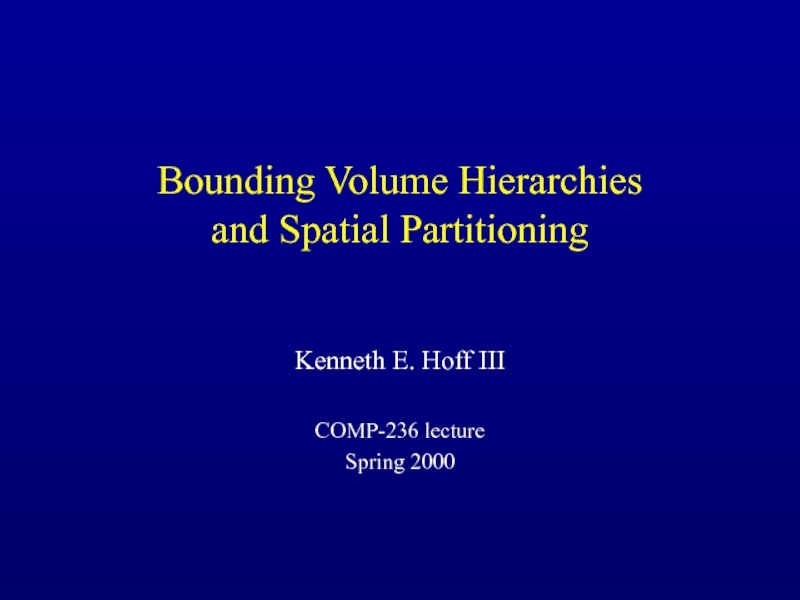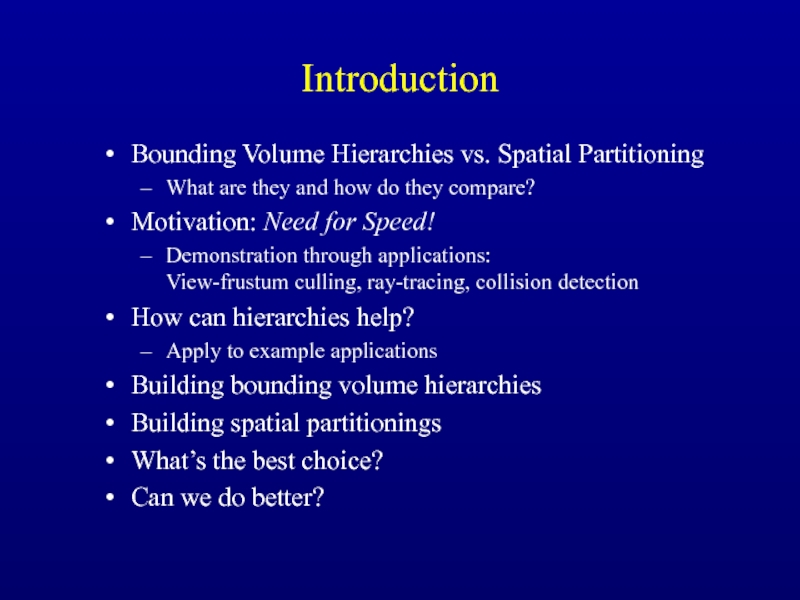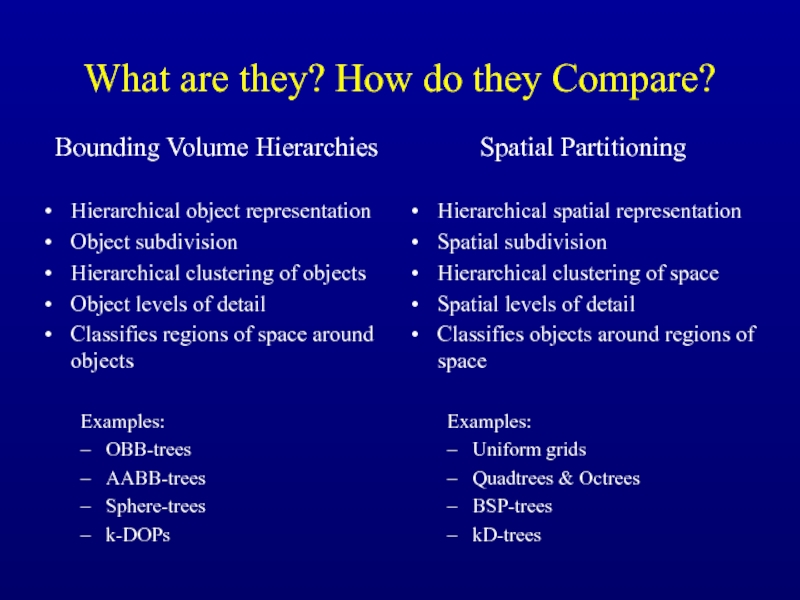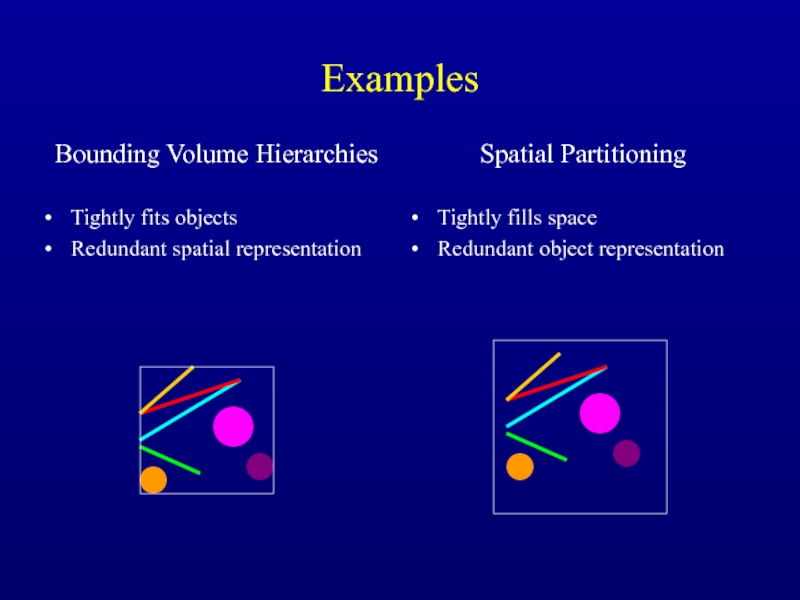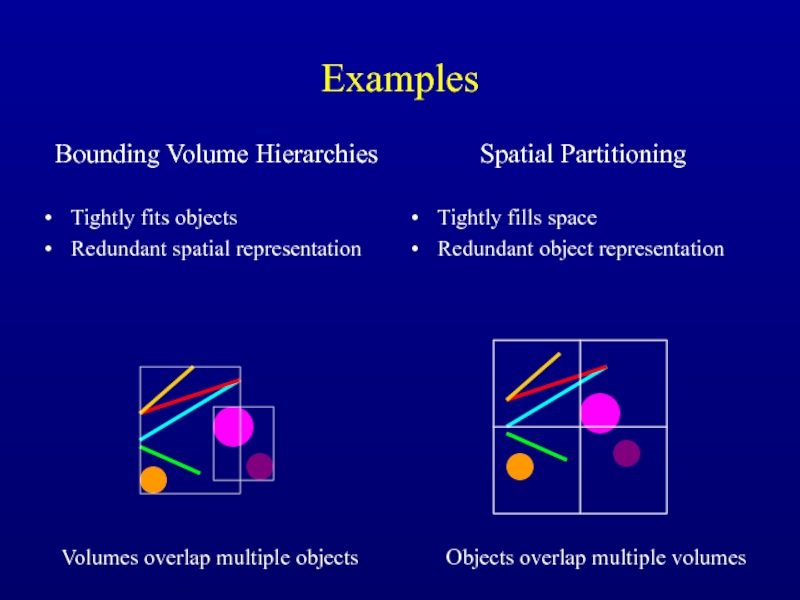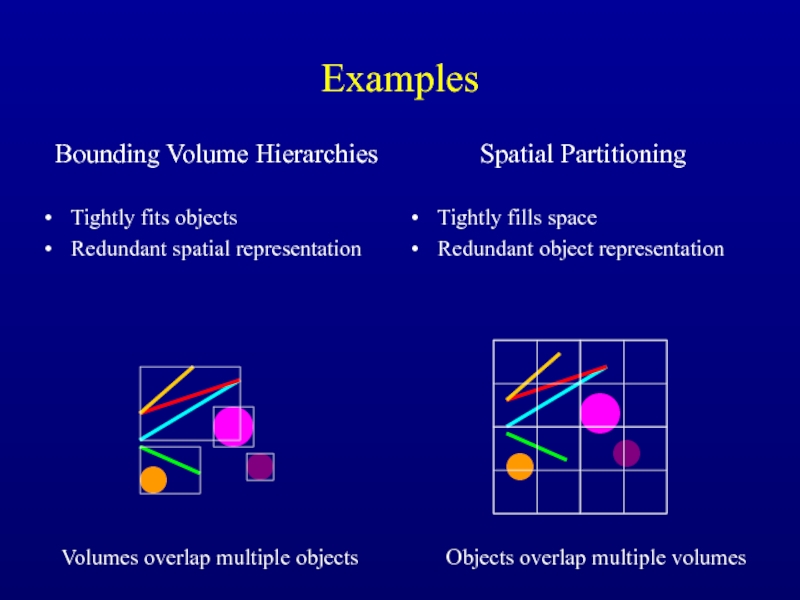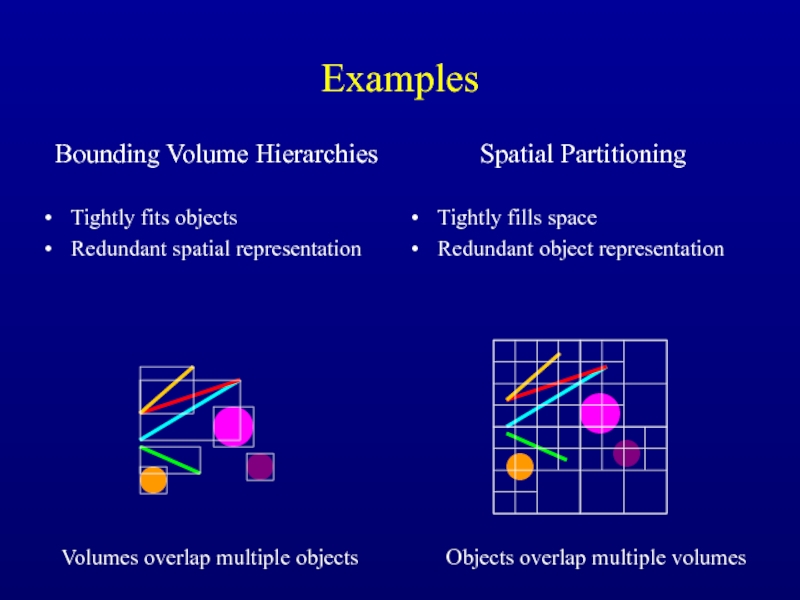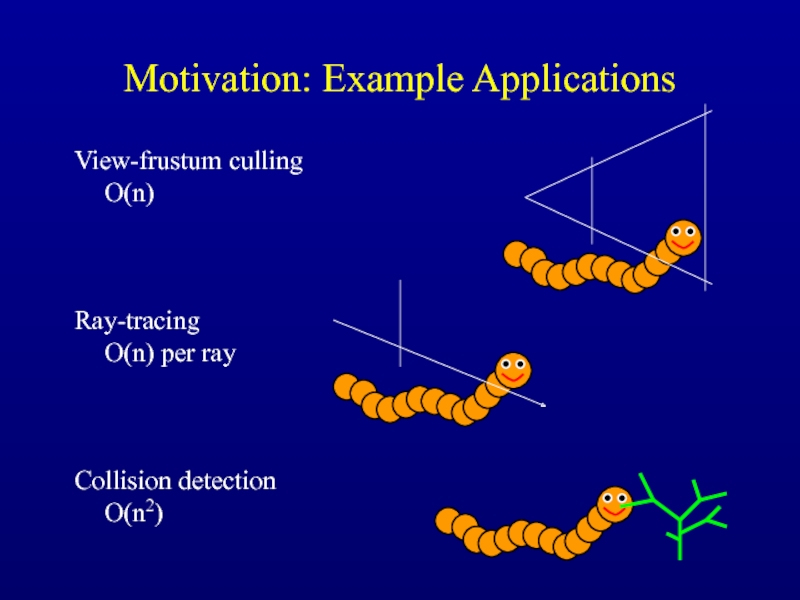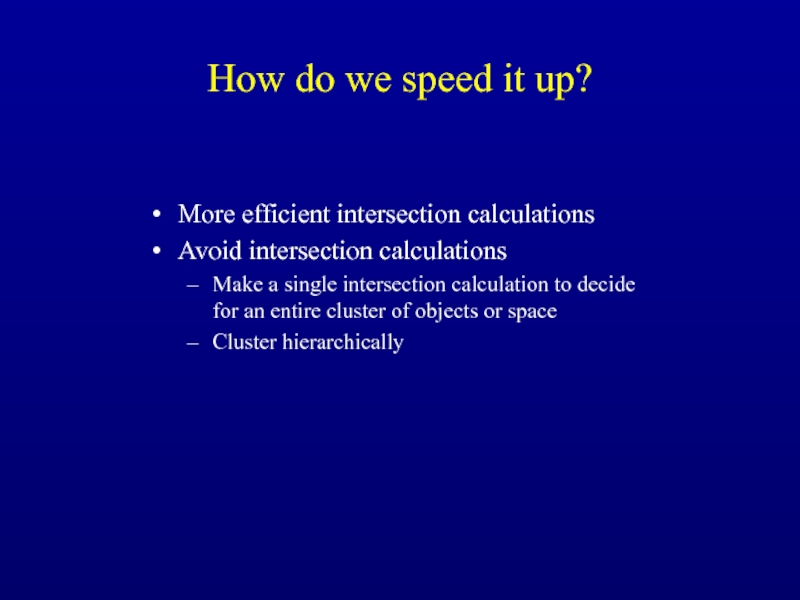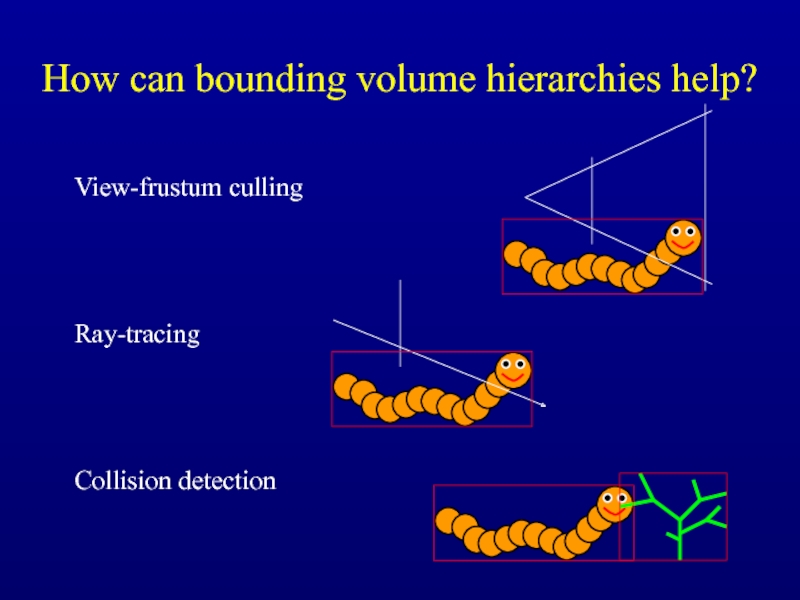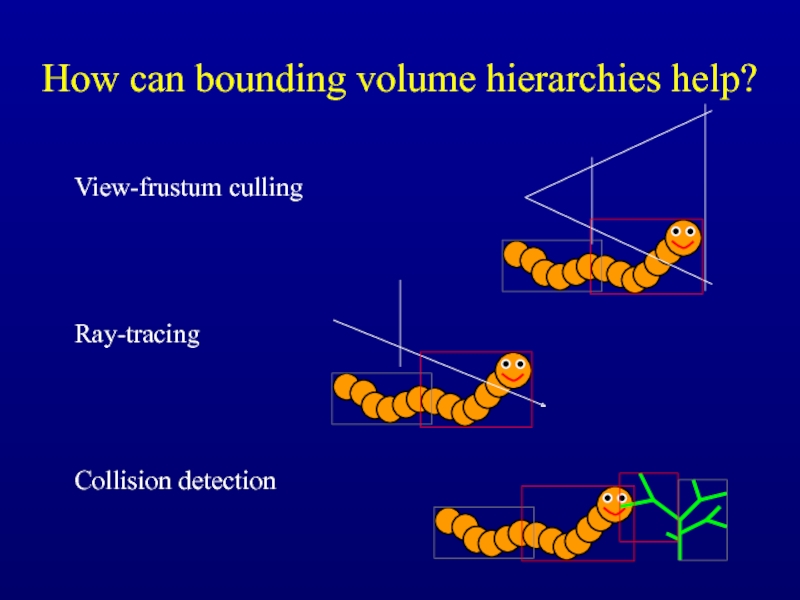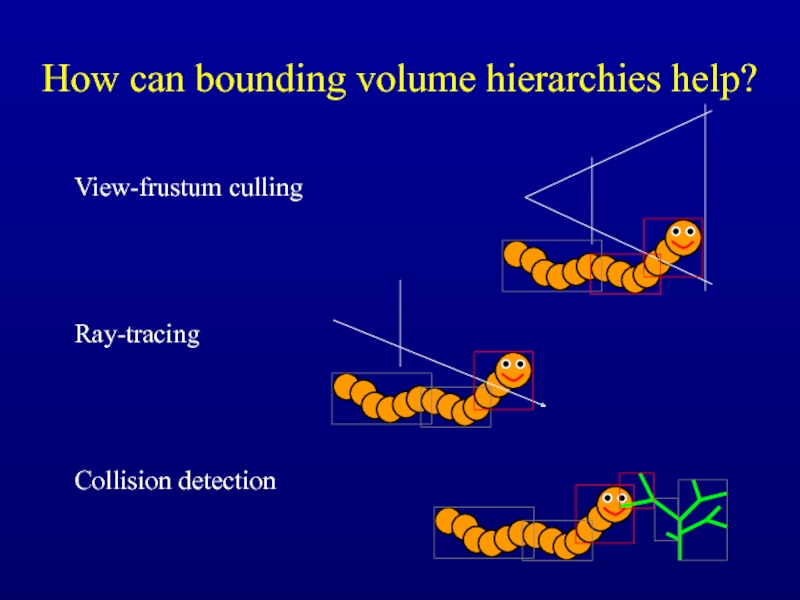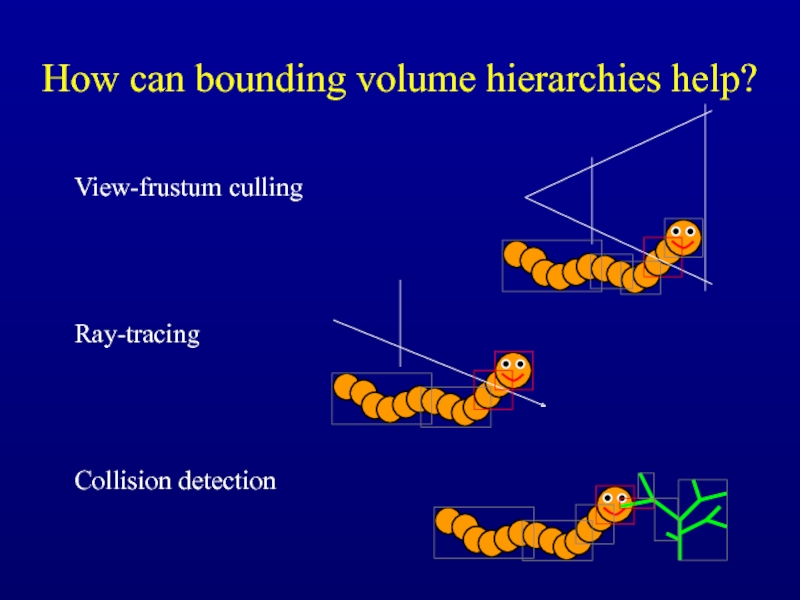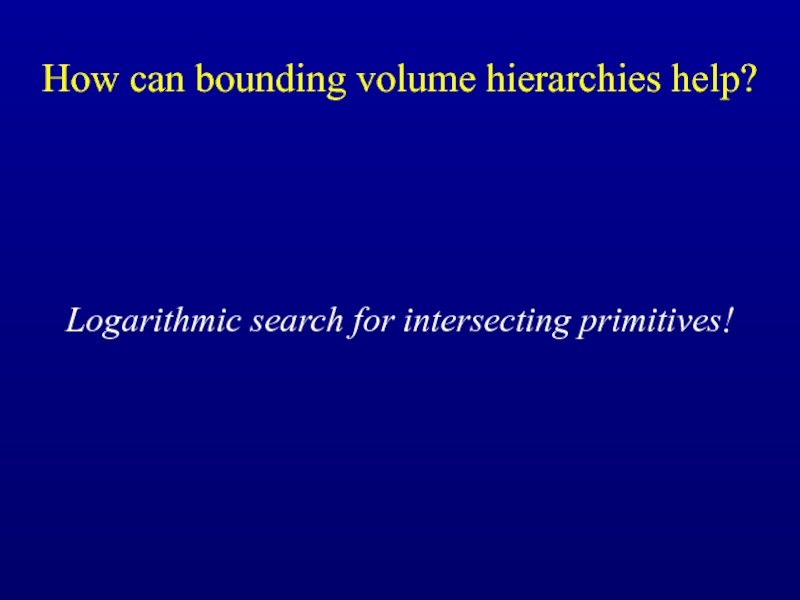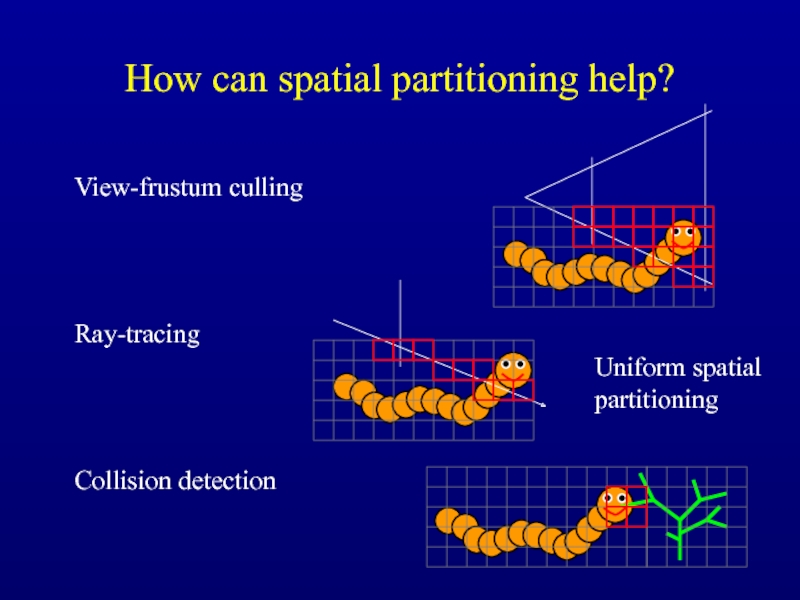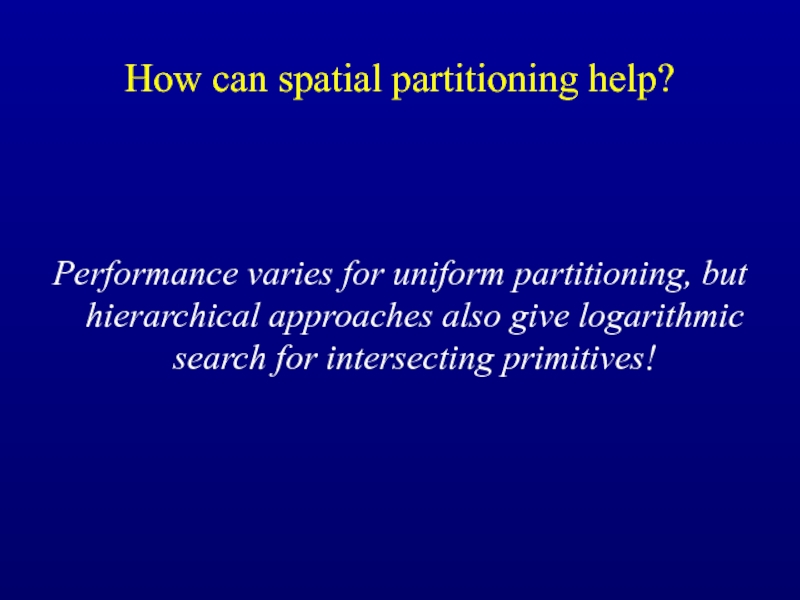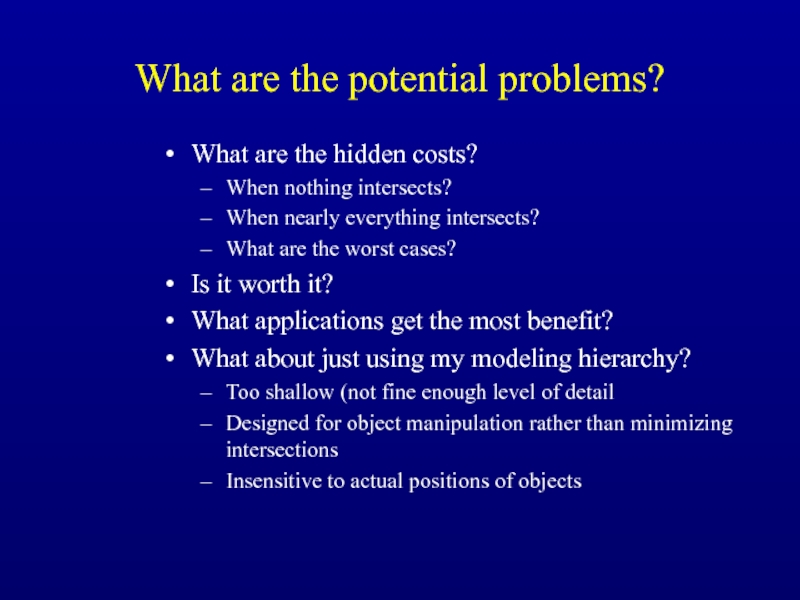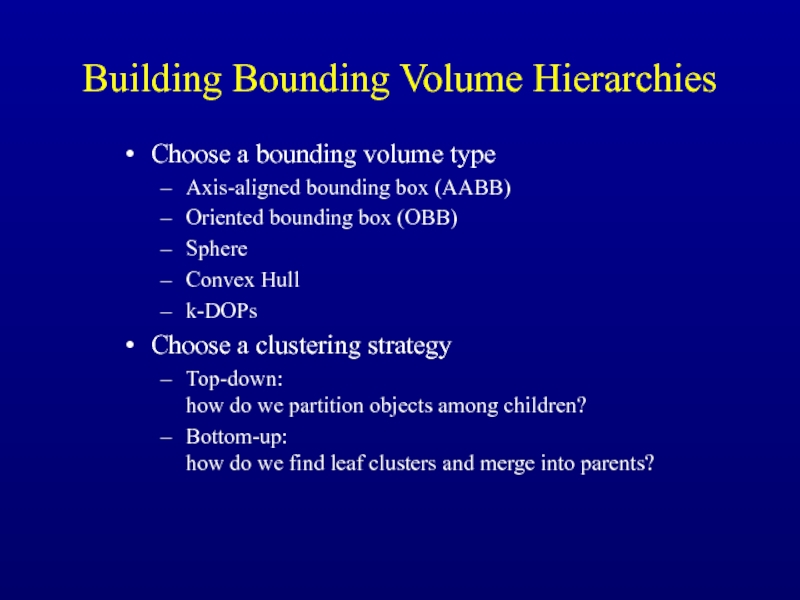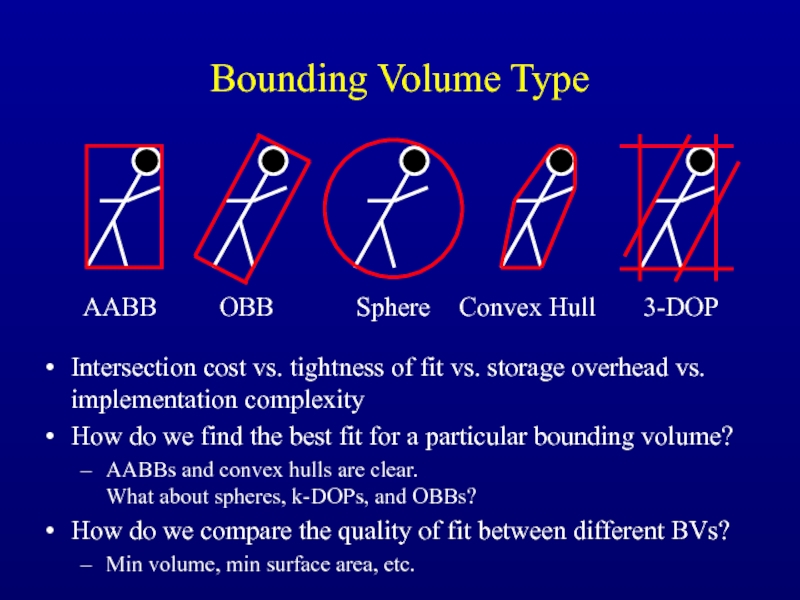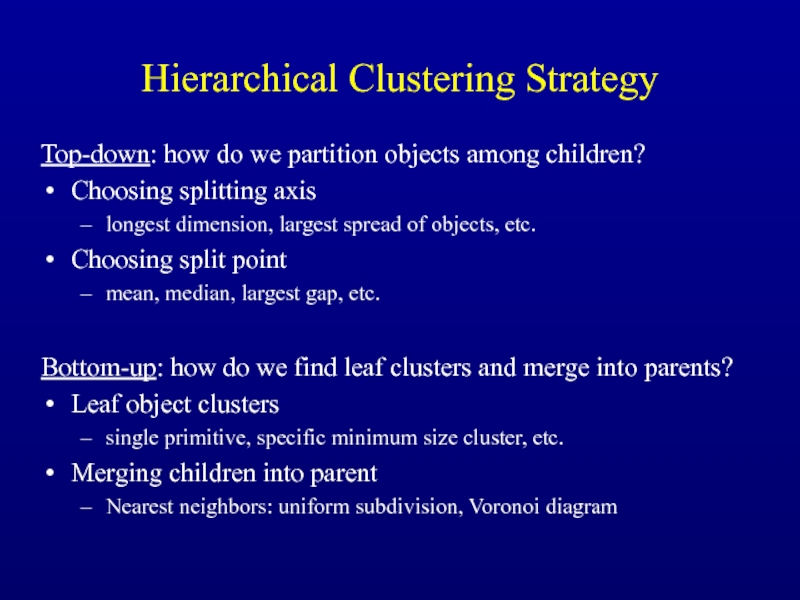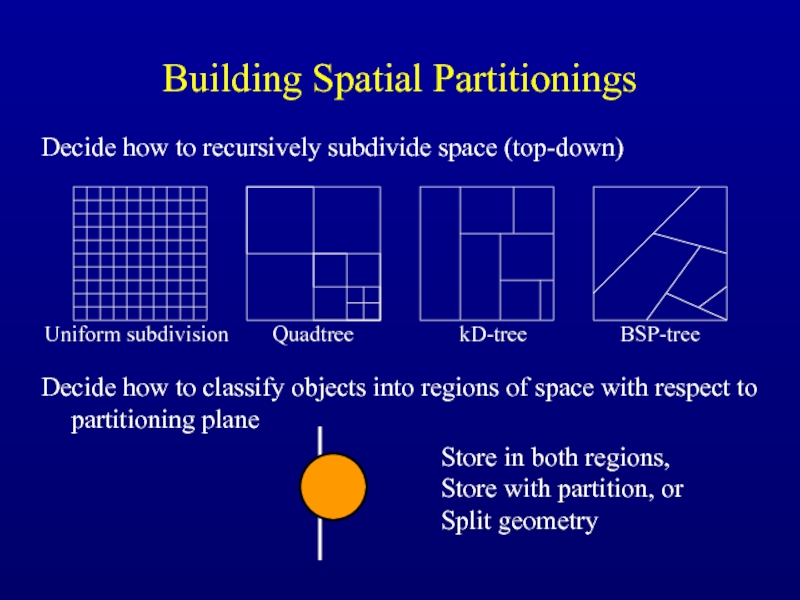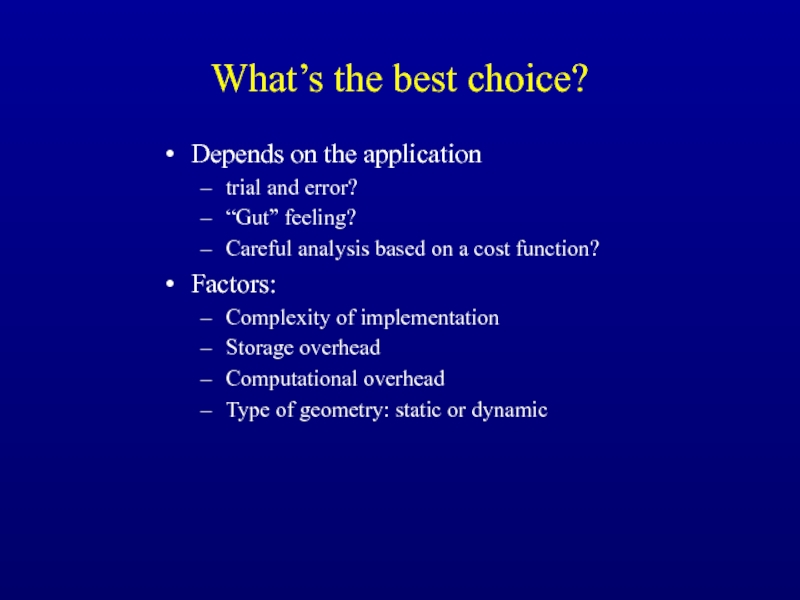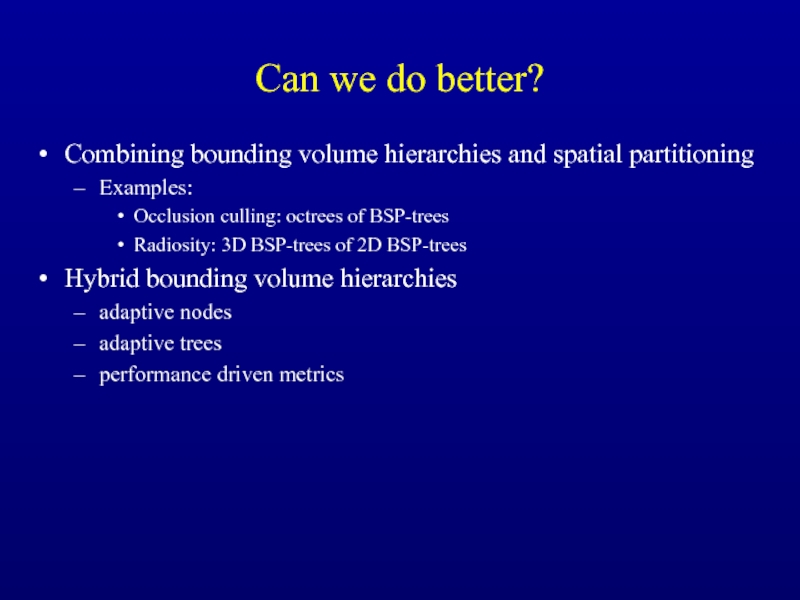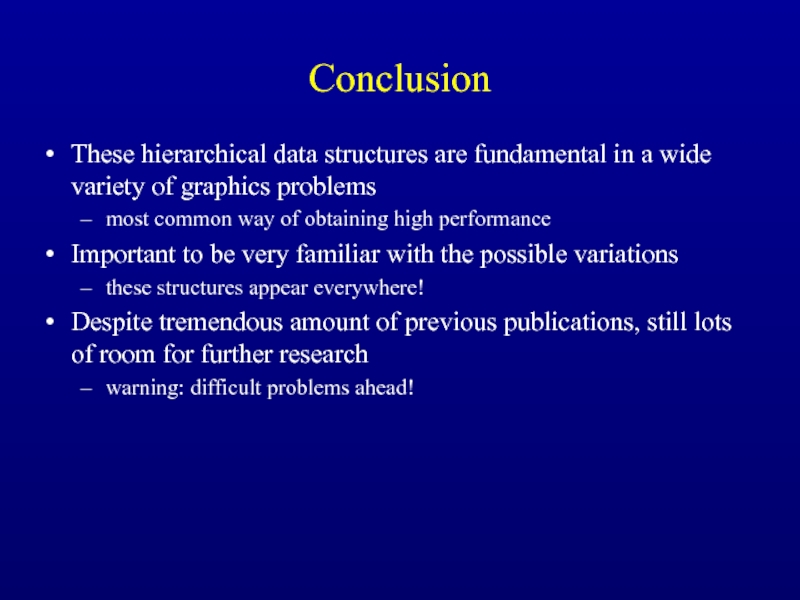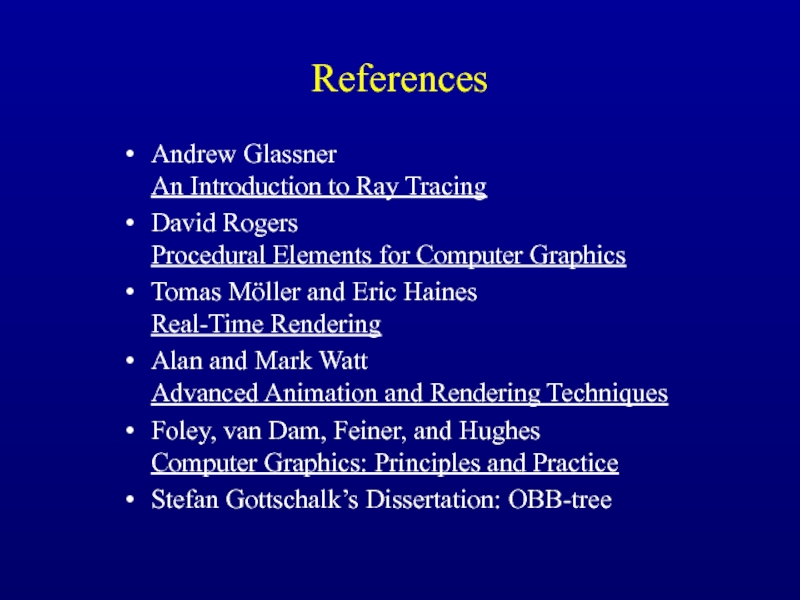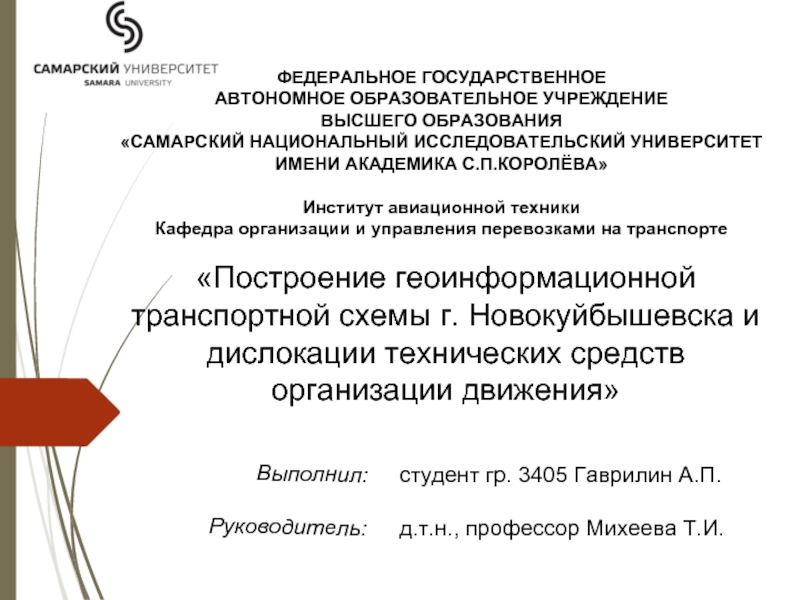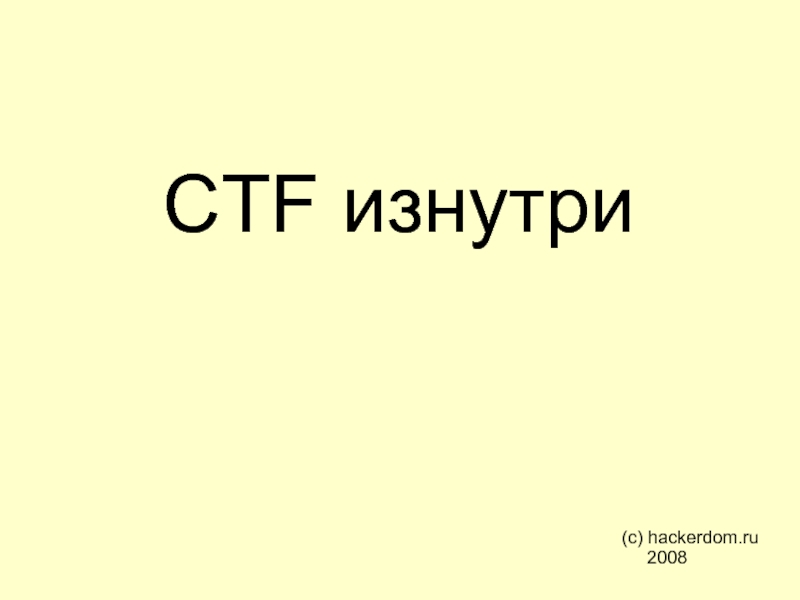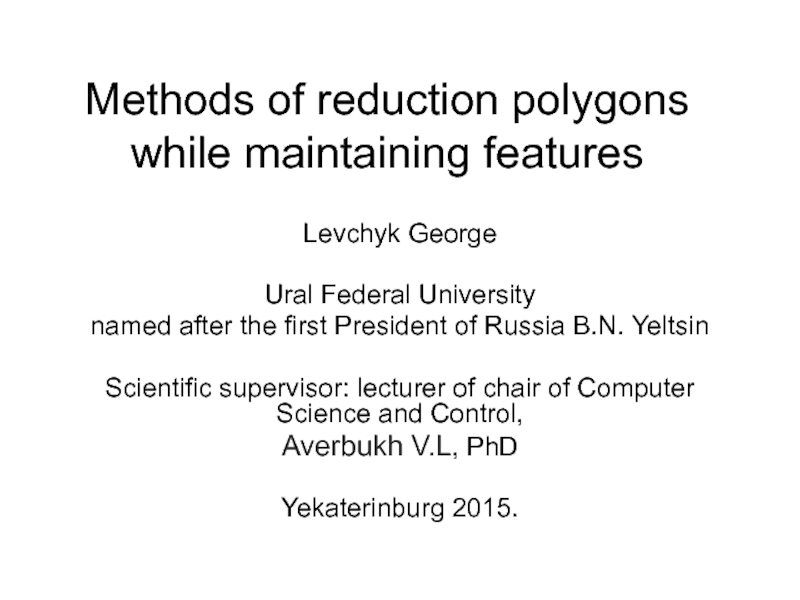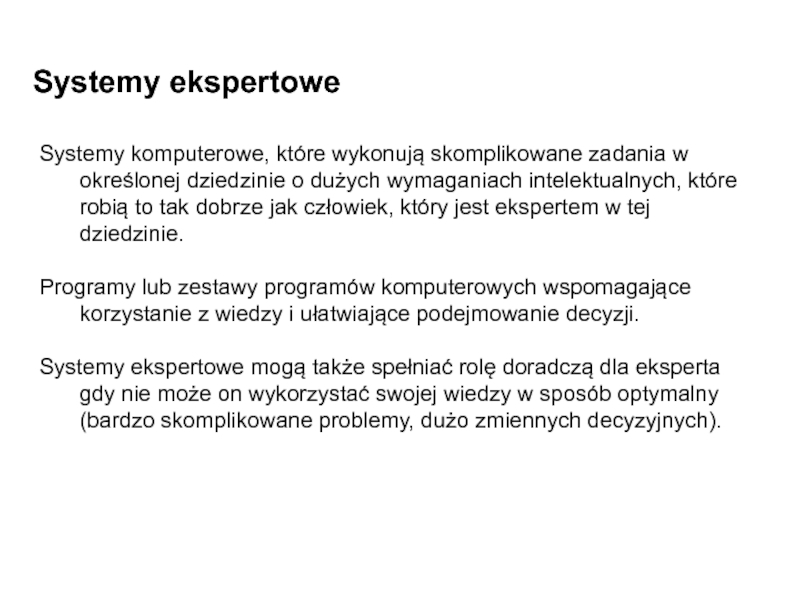- Главная
- Разное
- Дизайн
- Бизнес и предпринимательство
- Аналитика
- Образование
- Развлечения
- Красота и здоровье
- Финансы
- Государство
- Путешествия
- Спорт
- Недвижимость
- Армия
- Графика
- Культурология
- Еда и кулинария
- Лингвистика
- Английский язык
- Астрономия
- Алгебра
- Биология
- География
- Детские презентации
- Информатика
- История
- Литература
- Маркетинг
- Математика
- Медицина
- Менеджмент
- Музыка
- МХК
- Немецкий язык
- ОБЖ
- Обществознание
- Окружающий мир
- Педагогика
- Русский язык
- Технология
- Физика
- Философия
- Химия
- Шаблоны, картинки для презентаций
- Экология
- Экономика
- Юриспруденция
Bounding volume hierarchies and spatial partitioning презентация
Содержание
- 1. Bounding volume hierarchies and spatial partitioning
- 2. Introduction Bounding Volume Hierarchies vs. Spatial Partitioning
- 3. What are they? How do they Compare?
- 4. Examples Bounding Volume Hierarchies Tightly fits
- 5. Examples Bounding Volume Hierarchies Tightly fits
- 6. Examples Bounding Volume Hierarchies Tightly fits
- 7. Examples Bounding Volume Hierarchies Tightly fits
- 8. Motivation: Example Applications View-frustum culling O(n) Ray-tracing
- 9. How do we speed it up? More
- 10. How can bounding volume hierarchies help? View-frustum
- 11. How can bounding volume hierarchies help? View-frustum
- 12. How can bounding volume hierarchies help? View-frustum
- 13. How can bounding volume hierarchies help? View-frustum
- 14. How can bounding volume hierarchies help? Logarithmic search for intersecting primitives!
- 15. How can spatial partitioning help? View-frustum culling
- 16. How can spatial partitioning help? Performance varies
- 17. What are the potential problems? What are
- 18. Building Bounding Volume Hierarchies Choose a bounding
- 19. Bounding Volume Type Intersection cost vs. tightness
- 20. Hierarchical Clustering Strategy Top-down: how do we
- 21. Building Spatial Partitionings Decide how to recursively
- 22. What’s the best choice? Depends on the
- 23. Can we do better? Combining bounding volume
- 24. Conclusion These hierarchical data structures are fundamental
- 25. References Andrew Glassner An Introduction to Ray
Слайд 1Bounding Volume Hierarchies
and Spatial Partitioning
Kenneth E. Hoff III
COMP-236 lecture
Spring 2000
Слайд 2Introduction
Bounding Volume Hierarchies vs. Spatial Partitioning
What are they and how do
Motivation: Need for Speed!
Demonstration through applications: View-frustum culling, ray-tracing, collision detection
How can hierarchies help?
Apply to example applications
Building bounding volume hierarchies
Building spatial partitionings
What’s the best choice?
Can we do better?
Слайд 3What are they? How do they Compare?
Bounding Volume Hierarchies
Hierarchical object representation
Object
Hierarchical clustering of objects
Object levels of detail
Classifies regions of space around objects
Examples:
OBB-trees
AABB-trees
Sphere-trees
k-DOPs
Spatial Partitioning
Hierarchical spatial representation
Spatial subdivision
Hierarchical clustering of space
Spatial levels of detail
Classifies objects around regions of space
Examples:
Uniform grids
Quadtrees & Octrees
BSP-trees
kD-trees
Слайд 4Examples
Bounding Volume Hierarchies
Tightly fits objects
Redundant spatial representation
Spatial Partitioning
Tightly fills space
Redundant object
Слайд 5Examples
Bounding Volume Hierarchies
Tightly fits objects
Redundant spatial representation
Spatial Partitioning
Tightly fills space
Redundant object
Volumes overlap multiple objects
Objects overlap multiple volumes
Слайд 6Examples
Bounding Volume Hierarchies
Tightly fits objects
Redundant spatial representation
Spatial Partitioning
Tightly fills space
Redundant object
Volumes overlap multiple objects
Objects overlap multiple volumes
Слайд 7Examples
Bounding Volume Hierarchies
Tightly fits objects
Redundant spatial representation
Spatial Partitioning
Tightly fills space
Redundant object
Volumes overlap multiple objects
Objects overlap multiple volumes
Слайд 8Motivation: Example Applications
View-frustum culling O(n)
Ray-tracing
O(n) per ray
Collision detection
O(n2)
Слайд 9How do we speed it up?
More efficient intersection calculations
Avoid intersection calculations
Make
Cluster hierarchically
Слайд 15How can spatial partitioning help?
View-frustum culling
Ray-tracing
Collision detection
Uniform spatial partitioning
Слайд 16How can spatial partitioning help?
Performance varies for uniform partitioning, but hierarchical
Слайд 17What are the potential problems?
What are the hidden costs?
When nothing intersects?
When
What are the worst cases?
Is it worth it?
What applications get the most benefit?
What about just using my modeling hierarchy?
Too shallow (not fine enough level of detail
Designed for object manipulation rather than minimizing intersections
Insensitive to actual positions of objects
Слайд 18Building Bounding Volume Hierarchies
Choose a bounding volume type
Axis-aligned bounding box (AABB)
Oriented
Sphere
Convex Hull
k-DOPs
Choose a clustering strategy
Top-down: how do we partition objects among children?
Bottom-up: how do we find leaf clusters and merge into parents?
Слайд 19Bounding Volume Type
Intersection cost vs. tightness of fit vs. storage overhead
How do we find the best fit for a particular bounding volume?
AABBs and convex hulls are clear. What about spheres, k-DOPs, and OBBs?
How do we compare the quality of fit between different BVs?
Min volume, min surface area, etc.
AABB
OBB
Sphere
Convex Hull
3-DOP
Слайд 20Hierarchical Clustering Strategy
Top-down: how do we partition objects among children?
Choosing splitting
longest dimension, largest spread of objects, etc.
Choosing split point
mean, median, largest gap, etc.
Bottom-up: how do we find leaf clusters and merge into parents?
Leaf object clusters
single primitive, specific minimum size cluster, etc.
Merging children into parent
Nearest neighbors: uniform subdivision, Voronoi diagram
Слайд 21Building Spatial Partitionings
Decide how to recursively subdivide space (top-down)
Decide how to
Store in both regions,
Store with partition, or
Split geometry
Uniform subdivision
Quadtree
kD-tree
BSP-tree
Слайд 22What’s the best choice?
Depends on the application
trial and error?
“Gut” feeling?
Careful analysis
Factors:
Complexity of implementation
Storage overhead
Computational overhead
Type of geometry: static or dynamic
Слайд 23Can we do better?
Combining bounding volume hierarchies and spatial partitioning
Examples:
Occlusion culling:
Radiosity: 3D BSP-trees of 2D BSP-trees
Hybrid bounding volume hierarchies
adaptive nodes
adaptive trees
performance driven metrics
Слайд 24Conclusion
These hierarchical data structures are fundamental in a wide variety of
most common way of obtaining high performance
Important to be very familiar with the possible variations
these structures appear everywhere!
Despite tremendous amount of previous publications, still lots of room for further research
warning: difficult problems ahead!
Слайд 25References
Andrew Glassner
An Introduction to Ray Tracing
David Rogers
Procedural Elements for Computer Graphics
Tomas
Alan and Mark Watt Advanced Animation and Rendering Techniques
Foley, van Dam, Feiner, and Hughes Computer Graphics: Principles and Practice
Stefan Gottschalk’s Dissertation: OBB-tree
